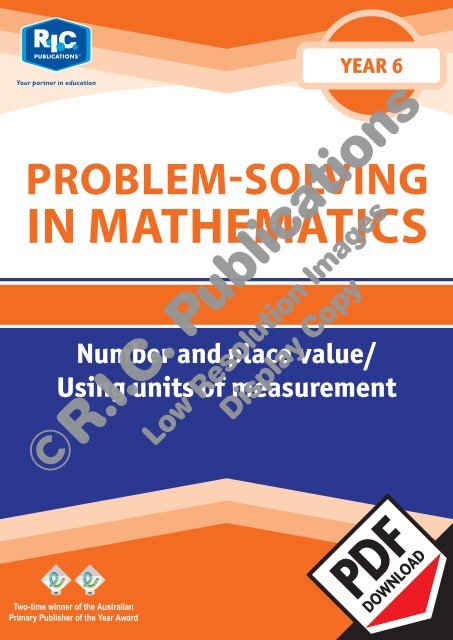20783_Problem_solving_Year_6_Number_and_place_value_Using_units_of_measurement
You also want an ePaper? Increase the reach of your titles
YUMPU automatically turns print PDFs into web optimized ePapers that Google loves.
Your partner in education<br />
YEAR 6<br />
PROBLEM-SOLVING<br />
IN MATHEMATICS<br />
<strong>Number</strong> <strong>and</strong> <strong>place</strong> <strong>value</strong>/<br />
<strong>Using</strong> <strong>units</strong> <strong>of</strong> <strong>measurement</strong><br />
Two-time winner <strong>of</strong> the Australian<br />
Primary Publisher <strong>of</strong> the <strong>Year</strong> Award
<strong>Problem</strong>-<strong>solving</strong> in mathematics<br />
(Book G)<br />
Published by R.I.C. Publications ® 2008<br />
Copyright © George Booker <strong>and</strong><br />
Denise Bond 2007<br />
RIC–<strong>20783</strong><br />
This master may only be reproduced by the<br />
original purchaser for use with their class(es). The<br />
publisher prohibits the loaning or onselling <strong>of</strong> this<br />
master for the purposes <strong>of</strong> reproduction.<br />
Copyright Notice<br />
Blackline masters or copy masters are published <strong>and</strong><br />
sold with a limited copyright. This copyright allows<br />
publishers to provide teachers <strong>and</strong> schools with a<br />
wide range <strong>of</strong> learning activities without copyright<br />
being breached. This limited copyright allows the<br />
purchaser to make sufficient copies for use within<br />
their own education institution. The copyright is not<br />
transferable, nor can it be onsold. Following these<br />
instructions is not essential but will ensure that you,<br />
as the purchaser, have evidence <strong>of</strong> legal ownership<br />
to the copyright if inspection occurs.<br />
For your added protection in the case <strong>of</strong> copyright<br />
inspection, please complete the form below. Retain<br />
this form, the complete original document <strong>and</strong> the<br />
invoice or receipt as pro<strong>of</strong> <strong>of</strong> purchase.<br />
Name <strong>of</strong> Purchaser:<br />
Date <strong>of</strong> Purchase:<br />
Supplier:<br />
School Order# (if applicable):<br />
Signature <strong>of</strong> Purchaser:<br />
Internet websites<br />
In some cases, websites or specific URLs may be recommended. While these are checked <strong>and</strong> rechecked at the time <strong>of</strong> publication,<br />
the publisher has no control over any subsequent changes which may be made to webpages. It is strongly recommended that the class<br />
teacher checks all URLs before allowing students to access them.<br />
View all pages online<br />
PO Box 332 Greenwood Western Australia 6924<br />
Website: www.ricpublications.com.au<br />
Email: mail@ricgroup.com.au
FOREWORD<br />
Books A–G <strong>of</strong> <strong>Problem</strong>-<strong>solving</strong> in mathematics have been developed to provide a rich resource for teachers<br />
<strong>of</strong> students from the early years to the end <strong>of</strong> middle school <strong>and</strong> into secondary school. The series <strong>of</strong> problems,<br />
discussions <strong>of</strong> ways to underst<strong>and</strong> what is being asked <strong>and</strong> means <strong>of</strong> obtaining solutions have been built up to<br />
improve the problem-<strong>solving</strong> performance <strong>and</strong> persistence <strong>of</strong> all students. It is a fundamental belief <strong>of</strong> the authors<br />
that it is critical that students <strong>and</strong> teachers engage with a few complex problems over an extended period rather than<br />
spend a short time on many straightforward ‘problems’ or exercises. In particular, it is essential to allow students<br />
time to review <strong>and</strong> discuss what is required in the problem-<strong>solving</strong> process before moving to another <strong>and</strong> different<br />
problem. This book includes extensive ideas for extending problems <strong>and</strong> solution strategies to assist teachers in<br />
implementing this vital aspect <strong>of</strong> mathematics in their classrooms. Also, the problems have been constructed <strong>and</strong><br />
selected over many years’ experience with students at all levels <strong>of</strong> mathematical talent <strong>and</strong> persistence, as well as<br />
in discussions with teachers in classrooms, pr<strong>of</strong>essional learning <strong>and</strong> university settings.<br />
<strong>Problem</strong>-<strong>solving</strong> does not come easily to most people,<br />
so learners need many experiences engaging with<br />
problems if they are to develop this crucial ability. As<br />
they grapple with problem, meaning <strong>and</strong> find solutions,<br />
students will learn a great deal about mathematics<br />
<strong>and</strong> mathematical reasoning; for instance, how to<br />
organise information to uncover meanings <strong>and</strong> allow<br />
connections among the various facets <strong>of</strong> a problem<br />
to become more apparent, leading to a focus on<br />
organising what needs to be done rather than simply<br />
looking to apply one or more strategies. In turn, this<br />
extended thinking will help students make informed<br />
choices about events that impact on their lives <strong>and</strong> to<br />
interpret <strong>and</strong> respond to the decisions made by others<br />
at school, in everyday life <strong>and</strong> in further study.<br />
Student <strong>and</strong> teacher pages<br />
The student pages present problems chosen with a<br />
particular problem-<strong>solving</strong> focus <strong>and</strong> draw on a range<br />
<strong>of</strong> mathematical underst<strong>and</strong>ings <strong>and</strong> processes.<br />
For each set <strong>of</strong> related problems, teacher notes <strong>and</strong><br />
discussion are provided, as well as indications <strong>of</strong><br />
how particular problems can be examined <strong>and</strong> solved.<br />
Answers to the more straightforward problems <strong>and</strong><br />
detailed solutions to the more complex problems<br />
ensure appropriate explanations, the use <strong>of</strong> the<br />
pages, foster discussion among students <strong>and</strong> suggest<br />
ways in which problems can be extended. Related<br />
problems occur on one or more pages that extend the<br />
problem’s ideas, the solution processes <strong>and</strong> students’<br />
underst<strong>and</strong>ing <strong>of</strong> the range <strong>of</strong> ways to come to terms<br />
with what problems are asking.<br />
At the top <strong>of</strong> each teacher page, there is a statement<br />
that highlights the particular thinking that the<br />
problems will dem<strong>and</strong>, together with an indication<br />
<strong>of</strong> the mathematics that might be needed <strong>and</strong> a list<br />
<strong>of</strong> materials that could be used in seeking a solution.<br />
A particular focus for the page or set <strong>of</strong> three pages<br />
<strong>of</strong> problems then exp<strong>and</strong>s on these aspects. Each<br />
book is organised so that when a problem requires<br />
complicated strategic thinking, two or three problems<br />
occur on one page (supported by a teacher page with<br />
detailed discussion) to encourage students to find<br />
a solution together with a range <strong>of</strong> means that can<br />
be followed. More <strong>of</strong>ten, problems are grouped as a<br />
series <strong>of</strong> three interrelated pages where the level <strong>of</strong><br />
complexity gradually increases, while the associated<br />
teacher page examines one or two <strong>of</strong> the problems in<br />
depth <strong>and</strong> highlights how the other problems might be<br />
solved in a similar manner.<br />
R.I.C. Publications ® www.ricpublications.com.au <strong>Problem</strong>-<strong>solving</strong> in mathematics<br />
iii
FOREWORD<br />
Each teacher page concludes with two further aspects<br />
critical to successful teaching <strong>of</strong> problem-<strong>solving</strong>. A<br />
section on likely difficulties points to reasoning <strong>and</strong><br />
content inadequacies that experience has shown may<br />
well impede students’ success. In this way, teachers<br />
can be on the look out for difficulties <strong>and</strong> be prepared<br />
to guide students past these potential pitfalls. The<br />
final section suggests extensions to the problems to<br />
enable teachers to provide several related experiences<br />
with problems <strong>of</strong> these kinds in order to build a rich<br />
array <strong>of</strong> experiences with particular solution methods;<br />
for example, the numbers, shapes or <strong>measurement</strong>s<br />
in the original problems might change but leave the<br />
means to a solution essentially the same, or the<br />
context may change while the numbers, shapes or<br />
<strong>measurement</strong>s remain the same. Then numbers,<br />
shapes or <strong>measurement</strong>s <strong>and</strong> the context could be<br />
changed to see how the students h<strong>and</strong>le situations<br />
that appear different but are essentially the same<br />
as those already met <strong>and</strong> solved. Other suggestions<br />
ask students to make <strong>and</strong> pose their own problems,<br />
investigate <strong>and</strong> present background to the problems<br />
or topics to the class, or consider solutions at a more<br />
general level (possibly involving verbal descriptions<br />
<strong>and</strong> eventually pictorial or symbolic arguments).<br />
In this way, not only are students’ ways <strong>of</strong> thinking<br />
extended but the problems written on one page are<br />
used to produce several more problems that utilise<br />
the same approach.<br />
Mathematics <strong>and</strong> language<br />
The difficulty <strong>of</strong> the mathematics gradually increases<br />
over the series, largely in line with what is taught<br />
at the various year levels, although problem-<strong>solving</strong><br />
both challenges at the point <strong>of</strong> the mathematics<br />
that is being learned as well as provides insights<br />
<strong>and</strong> motivation for what might be learned next. For<br />
example, the computation required gradually builds<br />
from additive thinking, using addition <strong>and</strong> subtraction<br />
separately <strong>and</strong> together, to multiplicative thinking,<br />
where multiplication <strong>and</strong> division are connected<br />
conceptions. More complex interactions <strong>of</strong> these<br />
operations build up over the series as the operations<br />
are used to both come to terms with problems’<br />
meanings <strong>and</strong> to achieve solutions. Similarly, twodimensional<br />
geometry is used at first but extended<br />
to more complex uses over the range <strong>of</strong> problems,<br />
then joined by interaction with three-dimensional<br />
ideas. Measurement, including chance <strong>and</strong> data, also<br />
extends over the series from length to perimeter, <strong>and</strong><br />
from area to surface area <strong>and</strong> volume, drawing on<br />
the relationships among these concepts to organise<br />
solutions as well as giving an underst<strong>and</strong>ing <strong>of</strong> the<br />
metric system. Time concepts range from interpreting<br />
timetables using 12-hour <strong>and</strong> 24-hour clocks while<br />
investigations related to mass rely on both the concept<br />
itself <strong>and</strong> practical <strong>measurement</strong>s.<br />
The language in which the problems are expressed is<br />
relatively straightforward, although this too increases<br />
in complexity <strong>and</strong> length <strong>of</strong> expression across the books<br />
in terms <strong>of</strong> both the context in which the problems<br />
are set <strong>and</strong> the mathematical content that is required.<br />
It will always be a challenge for some students<br />
to ‘unpack’ the meaning from a worded problem,<br />
particularly as problems’ context, information <strong>and</strong><br />
meanings exp<strong>and</strong>. This ability is fundamental to the<br />
nature <strong>of</strong> mathematical problem-<strong>solving</strong> <strong>and</strong> needs to<br />
be built up with time <strong>and</strong> experiences rather than be<br />
iv<br />
<strong>Problem</strong>-<strong>solving</strong> in mathematics www.ricpublications.com.au R.I.C. Publications ®
FOREWORD<br />
diminished or left out <strong>of</strong> the problems’ situations. One<br />
reason for the suggestion that students work in groups<br />
is to allow them to share <strong>and</strong> assist each other with<br />
the tasks <strong>of</strong> discerning meanings <strong>and</strong> ways to tackle<br />
the ideas in complex problems through discussion,<br />
rather than simply leaping into the first ideas that<br />
come to mind (leaving the full extent <strong>of</strong> the problem<br />
unrealised).<br />
An approach to <strong>solving</strong> problems<br />
Try<br />
an approach<br />
Explore<br />
means to a solution<br />
Analyse<br />
the problem<br />
The careful, gradual development <strong>of</strong> an ability to<br />
analyse problems for meaning, organising information<br />
to make it meaningful <strong>and</strong> to make the connections<br />
among them more meaningful in order to suggest<br />
a way forward to a solution is fundamental to the<br />
approach taken with this series, from the first book<br />
to the last. At first, materials are used explicitly to<br />
aid these meanings <strong>and</strong> connections; however, in<br />
time they give way to diagrams, tables <strong>and</strong> symbols<br />
as underst<strong>and</strong>ing <strong>and</strong> experience <strong>of</strong> <strong>solving</strong> complex,<br />
engaging problems increases. As the problem forms<br />
exp<strong>and</strong>, the range <strong>of</strong> methods to solve problems<br />
is carefully extended, not only to allow students to<br />
successfully solve the many types <strong>of</strong> problems, but<br />
also to give them a repertoire <strong>of</strong> solution processes<br />
that they can consider <strong>and</strong> draw on when new<br />
situations are encountered. In turn, this allows them<br />
to explore one or other <strong>of</strong> these approaches to see<br />
whether each might furnish a likely result. In this way,<br />
when they try a particular method to solve a new<br />
problem, experience <strong>and</strong> analysis <strong>of</strong> the particular<br />
situation assists them to develop a full solution.<br />
Not only is this model for the problem-<strong>solving</strong> process<br />
helpful in <strong>solving</strong> problems, it also provides a basis for<br />
students to discuss their progress <strong>and</strong> solutions <strong>and</strong><br />
determine whether or not they have fully answered<br />
a question. At the same time, it guides teacher<br />
questions <strong>of</strong> students <strong>and</strong> provides a means <strong>of</strong> seeing<br />
underlying mathematical difficulties <strong>and</strong> ways in<br />
which problems can be adapted to suit particular<br />
needs <strong>and</strong> extensions. Above all, it provides a common<br />
framework for discussions between a teacher <strong>and</strong><br />
group or whole class to focus on the problem-<strong>solving</strong><br />
process rather than simply on the solution <strong>of</strong> particular<br />
problems. Indeed, as Alan Schoenfeld, in Steen L (Ed)<br />
Mathematics <strong>and</strong> democracy (2001), states so well, in<br />
problem-<strong>solving</strong>:<br />
getting the answer is only the beginning rather than<br />
the end … an ability to communicate thinking is<br />
equally important.<br />
We wish all teachers <strong>and</strong> students who use these<br />
books success in fostering engagement with problem<strong>solving</strong><br />
<strong>and</strong> building a greater capacity to come to<br />
terms with <strong>and</strong> solve mathematical problems at all<br />
levels.<br />
George Booker <strong>and</strong> Denise Bond<br />
R.I.C. Publications ® www.ricpublications.com.au <strong>Problem</strong>-<strong>solving</strong> in mathematics<br />
v
CONTENTS<br />
Foreword .................................................................. iii – v<br />
Contents .......................................................................... vi<br />
Introduction ........................................................... vii – xix<br />
A note on calculator use ................................................ xx<br />
Teacher notes................................................................... 2<br />
Surface area...................................................................... 3<br />
Volume <strong>and</strong> surface area................................................. 4<br />
Surface area <strong>and</strong> volume................................................. 5<br />
Teacher notes................................................................... 6<br />
The farmers market.......................................................... 7<br />
Teacher notes................................................................... 8<br />
Pr<strong>of</strong>it <strong>and</strong> loss.................................................................. 9<br />
Calculator patterns........................................................ 10<br />
Puzzle scrolls.................................................................. 11<br />
Teacher notes................................................................. 12<br />
Weather or not............................................................... 13<br />
Showtime....................................................................... 14<br />
Probably true.................................................................. 15<br />
Teacher notes................................................................. 16<br />
Wilderness explorer....................................................... 17<br />
Teacher notes................................................................. 18<br />
Changing lockers............................................................ 19<br />
Cycle days...................................................................... 20<br />
Puzzle scrolls.................................................................. 21<br />
Teacher notes................................................................. 22<br />
Office hours.................................................................... 23<br />
At the <strong>of</strong>fice................................................................... 24<br />
Out <strong>of</strong> <strong>of</strong>fice................................................................... 25<br />
Teacher notes................................................................. 26<br />
<strong>Number</strong> patterns............................................................ 27<br />
Teacher notes................................................................. 28<br />
Magic squares............................................................... 29<br />
Sudoku........................................................................... 30<br />
Alphametic puzzles........................................................ 31<br />
Teacher notes................................................................. 32<br />
At the shops................................................................... 33<br />
The plant nursery........................................................... 34<br />
On the farm.................................................................... 35<br />
Teacher notes................................................................. 36<br />
Fisherman’s wharf.......................................................... 37<br />
Teacher notes................................................................. 38<br />
Making designs.............................................................. 39<br />
Squares <strong>and</strong> rectangles................................................. 40<br />
Designer squares........................................................... 41<br />
Teacher notes................................................................. 42<br />
How many?..................................................................... 43<br />
How far?......................................................................... 44<br />
How much?..................................................................... 45<br />
Teacher notes................................................................. 46<br />
Prospect Plains............................................................... 47<br />
Teacher notes................................................................. 48<br />
Money matters............................................................... 49<br />
Scoring points................................................................ 50<br />
Puzzle scrolls.................................................................. 51<br />
Teacher notes.................................................................. 52<br />
Riding to work................................................................. 53<br />
Bike tracks....................................................................... 54<br />
Puzzle scrolls................................................................... 55<br />
Teacher notes.................................................................. 56<br />
Farm work....................................................................... 57<br />
Farm produce.................................................................. 58<br />
Selling fish...................................................................... 59<br />
Teacher notes.................................................................. 60<br />
Rolling along................................................................... 61<br />
Solutions .................................................................62–71<br />
Isometric resource page .............................................. 72<br />
0–99 board resource page ........................................... 73<br />
4-digit number exp<strong>and</strong>er resource page (x 3) .............. 74<br />
10 mm x 10 mm grid resource page ........................... 75<br />
15 mm x 15 mm grid resource page ............................ 76<br />
Triangular grid resource page ...................................... 77<br />
vi<br />
<strong>Problem</strong>-<strong>solving</strong> in mathematics www.ricpublications.com.au R.I.C. Publications ®
TEACHER NOTES<br />
<strong>Problem</strong>-<strong>solving</strong><br />
To interpret <strong>and</strong> organise information in series <strong>of</strong><br />
interrelated statements <strong>and</strong> to use logical thinking to find<br />
solutions<br />
Focus<br />
These pages explore the concepts <strong>of</strong> average, distance,<br />
payments <strong>and</strong> interrelated statements within problem<br />
situations. Students need to read the problems carefully<br />
in order to take into consideration a number <strong>of</strong> different<br />
criteria. Tables <strong>and</strong> lists can be used to help manage the<br />
various criteria.<br />
Discussion<br />
Page 43<br />
Analysis <strong>of</strong> these investigations reveals a series <strong>of</strong><br />
interrelated statements which need to be taken into<br />
consideration in order to find a solution. A table or list can<br />
be very helpful to manage the data. For example in the<br />
first investigation, a table listing the different months can<br />
be used as a starting point. The problem states how many<br />
visitors there were during August <strong>and</strong> this information can<br />
be used to work out the number <strong>of</strong> visitors in July — 9000<br />
more. That information can in turn be used to work out the<br />
numbers for the other months. A similar table or list can<br />
be used for the other problems. In the investigation about<br />
the Pinnacles, the number <strong>of</strong> visitors in 2006 is not needed<br />
to find a solution. The last problem contains additional<br />
information about an increased per cent <strong>of</strong> visitors which<br />
is also not needed to find a solution.<br />
Page 44<br />
These problems explore the concept <strong>of</strong> average distance<br />
travelled over a period <strong>of</strong> time. In many cases the solution<br />
is not necessarily exact but rather an approximate time or<br />
distance. For example, the problem about running states<br />
that Paula runs 100 m in ‘about 45 seconds’. This is not an<br />
exact time <strong>and</strong> would vary from lap to lap so the solution<br />
<strong>of</strong> how far she has run would again be an approximate<br />
distance. The investigation about driving from Kalgoorlie<br />
to Perth contains information about morning tea <strong>and</strong> lunch<br />
that needs to be factored into the amount <strong>of</strong> time driving.<br />
If they leave at 9:15 in the morning, stop for 40 minutes<br />
for morning tea <strong>and</strong> then have lunch at 12:30 they have<br />
driven for 2 <strong>and</strong> 20 minutes not three hours. The problem<br />
involving the triathlon deals with the concept <strong>of</strong> distance<br />
over a month. Discussion could centre on how this would<br />
vary from month to month. A table could be constructed to<br />
show the distance for each month <strong>of</strong> the year.<br />
Page 45<br />
A careful reading <strong>of</strong> each problem is needed to determine<br />
what the problem is asking as some investigations<br />
have information not needed to find a solution. The first<br />
investigation requires students to calculate how many<br />
250 g packs can be made from 74 kg <strong>of</strong> cheese <strong>and</strong> how<br />
many 200 g packs can be made from 42 kg <strong>of</strong> sun-dried<br />
tomatoes <strong>and</strong> to use this to calculate how much pr<strong>of</strong>it is<br />
made across a year.<br />
In the problem about the shelving <strong>and</strong> brackets, it is<br />
important to keep in mind that each bracket needs six<br />
screw which come in packs <strong>of</strong> 10. Students need to<br />
calculate how many packets rather than how many screws<br />
are required.<br />
When exploring the problem about the tree seedlings, it is<br />
important to factor in that he is working on both Saturday<br />
<strong>and</strong> Sunday <strong>and</strong> thus getting paid at $47.50 per day <strong>and</strong><br />
not $32.75.<br />
Possible difficulties<br />
• Not using a table or list to manage the data<br />
• Not underst<strong>and</strong>ing average<br />
• Confusion when dealing with approximate times <strong>and</strong><br />
distances<br />
Extension<br />
• Construct a table to show the running distance <strong>and</strong><br />
how it varies from month to month.<br />
• Write other problems using the same form <strong>of</strong> complex<br />
reasoning for other students to solve.<br />
42<br />
<strong>Problem</strong>-<strong>solving</strong> in mathematics www.ricpublications.com.au R.I.C. Publications ®
HOW MANY?<br />
1. Around half a million people visit Uluru in the Northern Territory each year. Many <strong>of</strong><br />
these visitors go on to visit the Olgas which has about 200 000 people visit it each year.<br />
During August 178 000 tourist visited Uluru while May had twice as many visitors as<br />
January but 6000 less than July. July had 9 000 more visitors than August. How many<br />
visitors were there in January?<br />
2. Around 250 000 people visit the Pinnacles<br />
in Nambung National Park in Western<br />
Australia each year. Many people visit<br />
from August to October when the<br />
weather is cooler <strong>and</strong> the wildflowers are<br />
blooming. There were 1 half more visitors<br />
in 2008 than in 2004. There were 17 660<br />
more visitors in 2008 than in 2007 <strong>and</strong> 36<br />
180 less visitors in 2006 than 2007. 2005<br />
<strong>and</strong> 2004 had similar numbers with only<br />
5 790 more in 2005 than in 2004. If there<br />
were 152 980 visitors in 2005, how many<br />
were there in 2007?<br />
3. Blue Mountains west <strong>of</strong> Sydney experienced declining visitor numbers for several<br />
years. An extensive advertising campaign has helped gain an increase in visitors <strong>and</strong><br />
now about 2.6 million people visit the area each year. Both national <strong>and</strong> international<br />
visitor numbers have improved <strong>and</strong> 2008 saw an 18% increase in international visitors<br />
to the area.<br />
Many visitors attend the popular winter magic<br />
festival as well as the many other festivals <strong>and</strong><br />
events held throughout the year. During May there<br />
were 196 590 visitors. November had 36 470 more<br />
visitors than September <strong>and</strong> October had 37 210<br />
less than May. May had 10 270 less visitors than<br />
July <strong>and</strong> September had 12 400 less than July. July<br />
had 47 480 more visitors than October. How many<br />
visitors were there in November?<br />
R.I.C. Publications ® www.ricpublications.com.au <strong>Problem</strong>-<strong>solving</strong> in mathematics<br />
43
HOW FAR?<br />
1. Paula runs around a 400 m track on Mondays, Wednesdays <strong>and</strong> Fridays, <strong>and</strong> a 200 m<br />
track on Tuesday <strong>and</strong> Thursdays. She likes to pace herself <strong>and</strong> averages 100 m in about<br />
50 seconds. She usually runs for an hour on Tuesdays <strong>and</strong> Thursdays <strong>and</strong> 40 minutes on<br />
the other days. Approximately how far does she run each week?<br />
2. The Indian Pacific train travels from<br />
Sydney to Perth via Adelaide twice<br />
a week. The trip takes 65 hours <strong>and</strong><br />
covers a distance <strong>of</strong> 4352 km one<br />
way. Along the way, the train crosses<br />
the Nullarbor Plain <strong>and</strong> has an average<br />
speed <strong>of</strong><br />
85 km/h. If the train leaves Sydney at<br />
2:55 pm‚ how far will it have travelled<br />
after 13 hours?<br />
3. Davis swims every morning <strong>and</strong> usually swims 100 m in about 2 minutes <strong>and</strong> 5<br />
seconds. During the week, he swims at a 100 m pool near his work <strong>and</strong> on the<br />
weekends he swims in a 50 m pool near his house. He swims for about an hour each<br />
day. About how far does he swim each week?<br />
4. Rielly <strong>and</strong> Rita drove from Kalgoorlie to Perth, a distance <strong>of</strong> 596 km. They left at 9:15 in<br />
the morning <strong>and</strong> had lunch at 12:30. They stopped for 40 minutes at morning tea <strong>and</strong> an<br />
hour <strong>and</strong> 15 minutes at lunch. They averaged 90 km per hour before lunch <strong>and</strong> 95 km<br />
per hour after lunch. How far had they driven by 3 o’clock in the afternoon?<br />
5. Ranni trains each day for the triathlon. During the week she<br />
swims 2 km each morning <strong>and</strong> does a 4 km run on Tuesday<br />
<strong>and</strong> Thursday afternoons <strong>and</strong> a 5 km bike ride on Mondays,<br />
Wednesday <strong>and</strong> Friday afternoons. On the weekend she<br />
does a mini-triathlon where she does a 1 km swim, 2 km<br />
bike ride <strong>and</strong> a 3 km run. How far does she swim, run <strong>and</strong><br />
cycle each month?<br />
44<br />
<strong>Problem</strong>-<strong>solving</strong> in mathematics www.ricpublications.com.au R.I.C. Publications ®
1. Jack’s deli sells 74 kg <strong>of</strong> fetta cheese<br />
<strong>and</strong> 42 kg <strong>of</strong> sun-dried tomatoes each<br />
month. He buys the fetta cheese in<br />
10 kg containers for $96.50 <strong>and</strong> the<br />
sun-dried tomatoes in 3 kg tins for<br />
$37.00. He then re-packs the cheese<br />
into 250 g tubs that he sells for $4.50<br />
each‚ <strong>and</strong> the tomatoes into 200 g<br />
tubs which he sells for $4.00 each.<br />
How much pr<strong>of</strong>it does he make each<br />
month on fetta cheese?<br />
HOW MUCH?<br />
2. Mal pots tree seedlings for the local forestry group to plant for forest revegetation.<br />
He can be paid by the day or by the number <strong>of</strong> tree seedlings he pots. He can be<br />
paid $1.15 per seedling‚ or $35.75 per day on weekdays <strong>and</strong> $47.50 per day on the<br />
weekends. He can usually pot about 285 seedlings per week. If he works from Friday<br />
to Thursday, which is the best payment option <strong>and</strong> by how much?<br />
3. Brent bought avocados from the market at 8 for $9 <strong>and</strong> sold them at his fruit shop for 3<br />
for $5. Over the weekend he made a pr<strong>of</strong>it <strong>of</strong> $65. How many avocados did he sell?<br />
4. The hardware shop sells shelving with<br />
brackets <strong>and</strong> screws <strong>and</strong> without brackets<br />
<strong>and</strong> screws. Shelving with brackets <strong>and</strong><br />
screws costs $32.50 per shelf. Shelving<br />
without brackets <strong>and</strong> screws costs $18.00;<br />
brackets cost $2.75 each <strong>and</strong> screws cost 10<br />
for $1.00. Each shelf needs 3 brackets <strong>and</strong><br />
each bracket has 6 screws. If Aaron wants<br />
to put up 3 shelves, which is the cheaper<br />
option <strong>and</strong> by how much?<br />
5. Beau has 20 cabins he rents to holiday-makers. He bought some new sheets for the<br />
cabins <strong>and</strong> paid $304 for sheets that cost $19 each. The next day he saw the same<br />
sheets available for $16‚ so he bought twice as many as the day before. How much did<br />
he spend on sheets?<br />
R.I.C. Publications ® www.ricpublications.com.au <strong>Problem</strong>-<strong>solving</strong> in mathematics<br />
45
SOLUTIONS<br />
Note: Many solutions are written statements rather than just numbers. This is to encourage teachers <strong>and</strong> students to solve<br />
problems in this way.<br />
HOW MANY? ............................................................. page 43<br />
1. 90 500 visitors<br />
2. 203 125 visitors<br />
3. 230 930 visitors<br />
HOW FAR? .................................................................. page 44<br />
1. 12 km per week<br />
2. 1105 km<br />
3. He swims 2880 m per day – about 20 km per week<br />
4. 375 km<br />
5. Each week she swims 12 km, runs 14 km <strong>and</strong> bikes 19<br />
km. Assuming 4 weeks in a month.<br />
She swims 48 km, runs 56 km <strong>and</strong> bikes 76 km per<br />
month.<br />
HOW MUCH? ............................................................. page 45<br />
1. $560<br />
2. $327.75 Payment per seedling is better than $273.75 by<br />
$54<br />
3. 120<br />
4. $84.75 for shelving without brackets <strong>and</strong> screws is<br />
cheaper than $97.50 for shelving with brackets <strong>and</strong><br />
screws by $12.75<br />
5. $816<br />
R.I.C. Publications ® www.ricpublications.com.au <strong>Problem</strong>-<strong>solving</strong> in mathematics<br />
69


















